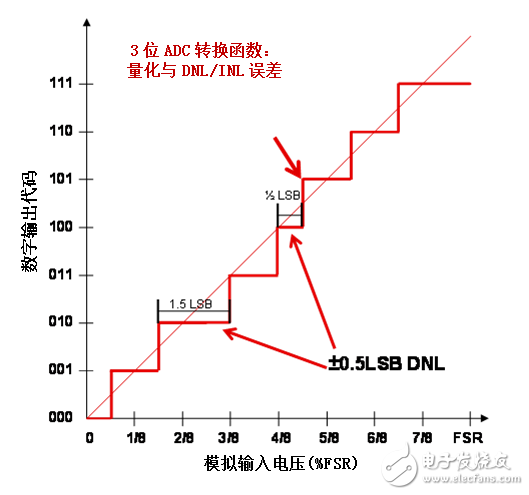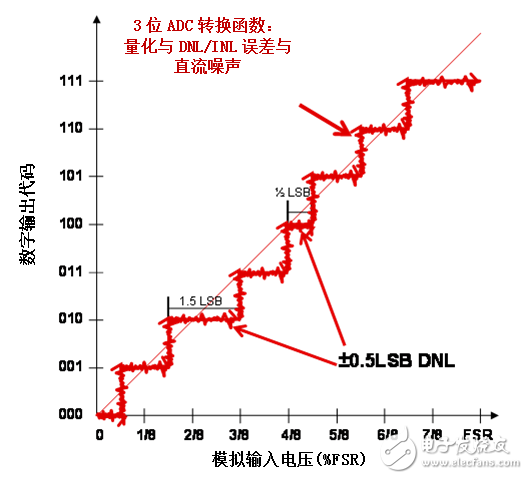What is the nonlinearity of analog-to-digital converters
Time:2024-01-12
Views:373
Last week, I replaced the carpet at home with wooden flooring. After removing the carpet from the living room staircase, I noticed that the depth and width of the originally "consistent" staircase steps were actually very uneven. I am very surprised about this because over the years, I have never noticed that the steps are uneven. This is because the carpet cleverly masks this issue.



With my nerdy way of thinking, this reminds me of the issue of high-resolution SAR analog-to-digital converters (ADCs). I used to think that my stairs were uniform, just like the ideal conversion function of a noise free ADC with perfectly symmetrical quantization steps. Figure 1 shows an example of a 3-bit ADC.

Figure 1. ADC Conversion Function - "Uniform and Consistent Stairs"
This made me, a bookworm, think again. The imperfect staircase in my house is non-linear in size (Figure 2), which is very similar to the situation where ADC code conversion will never be completely uniform. The non-uniformity of ADC mainly depends on two aspects, namely differential nonlinearity (DNL) error and integral nonlinearity (INL) error. Both of these errors are caused by the inherent mismatch between the ADC‘s internal capacitors and resistors.

Figure 2. ADC nonlinearity - "real stairs"
In addition, the function of the staircase carpet is like a layer of DC "conversion noise" added (and overlapped) to the ADC conversion function (Figure 3). This noise comes from the internal circuits of the ADC, including the reference source. The noise threshold can conceal the true nonlinear shape of the ADC step response.

Figure 3. ADC Nonlinear Noise - "Staircase with Carpet"
Just like the stairs at home, this information is not obvious in the ADC data table. However, the ADC specification table lists typical values of noise power, namely the root mean square value of "conversion noise".
In addition, the value can also be found in the DC histogram in the "Typical Curve" section of the data table. The distribution of output code represents the peak to peak conversion noise, which is usually equal to a small amount of LSB. Figure 4 illustrates this using 18 bit SAR ADC ADS8881 as an example.
Electrical characteristics
The minimum and maximum conditions for all specifications are TA=-40 ℃ to+85 ℃, AVDD=3V, DVDD=3V, VREF=5V, VCM=VREF/2V, fSAMPLE=1 MSPS, unless otherwise specified. The typical specification conditions are TA=+25 ℃, AVDD=3V, DVDD=3V.
Do you want to understand the nonlinearity of analog-to-digital converters? Peel off the carpet and take a look
Figure 4. The ADS8881 data table presents the conversion noise and DC histogram curves
What would happen if DNL/INL were used to quantify the "non-uniformity" of stairs? It is sometimes difficult to understand how to measure DNL/INL to achieve a higher level of accuracy than peak to peak conversion noise, and to ensure implementation.
Taking ADS8881 (Figure 5) as an example. How can the DNLMAX specification value of 1.5LSB be displayed when there is an error of up to+5LSB in the ADC output signal due to conversion noise issues? In other words, how can we see its unevenness when laying carpets on stairs?
Electrical characteristics
The minimum and maximum conditions for all specifications are TA=-40 ℃ to+85 ℃, AVDD=3V, DVDD=3V, VREF=5V, VCM=VREF/2V, fSAMPLE=1 MSPS, unless otherwise specified. The typical specification conditions are TA=+25 ℃, AVDD=3V, DVDD=3V.
Do you want to understand the nonlinearity of analog-to-digital converters? Peel off the carpet and take a look
Figure 5. ADS8881 data table provides DNL and INL specifications
Actually, I have already given the answer - remove the carpet! Similarly, to measure the true linearity (INL/DNL) of high-resolution ADCs, it is necessary to first eliminate DC conversion noise and then observe the noise threshold below.
In ADC, the average method is the main tool for eliminating the noise "carpet" in ADC, used to measure the correct INL/DNL, because the conversion noise has white noise characteristics.
To obtain the average value, it is necessary to apply a known voltage from a very stable reference or digital to analog converter (DAC) output, then perform multiple sampling and conversion to stabilize the input voltage, and calculate the average value of the digital output code to determine the linearity of the specific point.
If you feel confused while reading the ADC product manual, take some time to clarify your thoughts and think about the staircase metaphor I introduced. This will make the non-linear problem of ADC suddenly clear!
|
Disclaimer: This article is transferred from other platforms and does not represent the views and positions of this site. If there is any infringement or objection, please contact us to delete it. thank you! |











